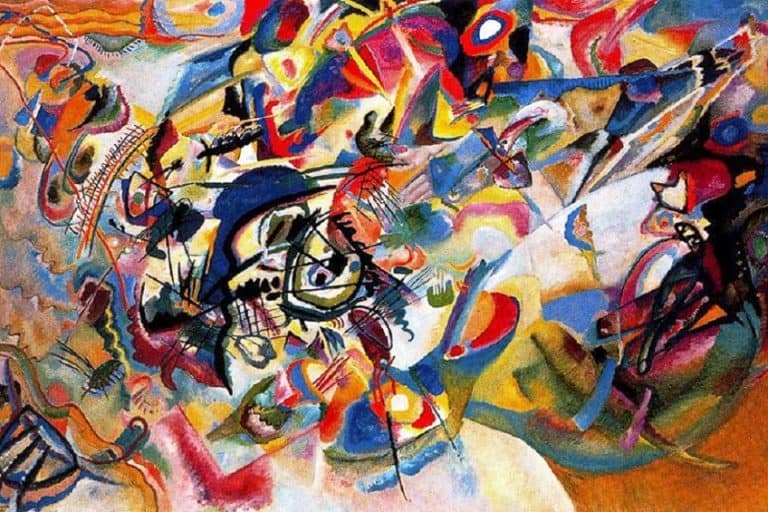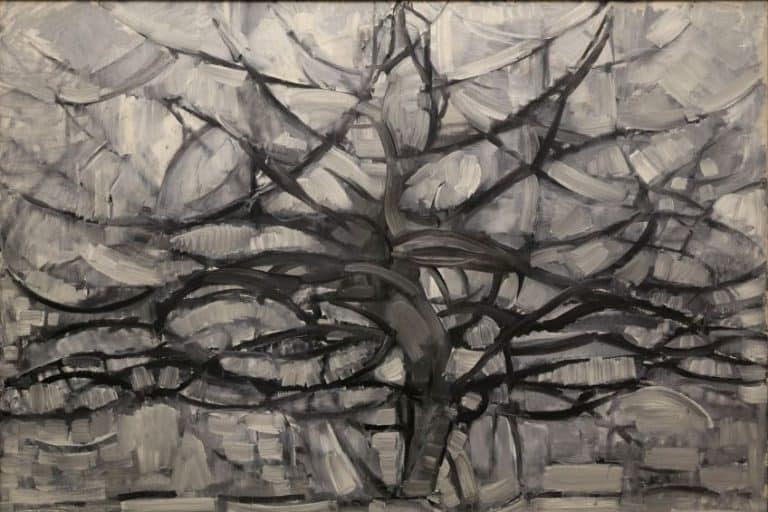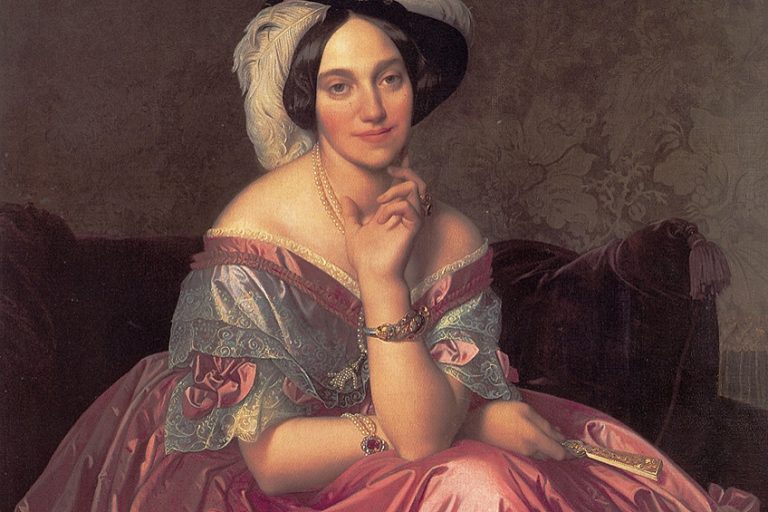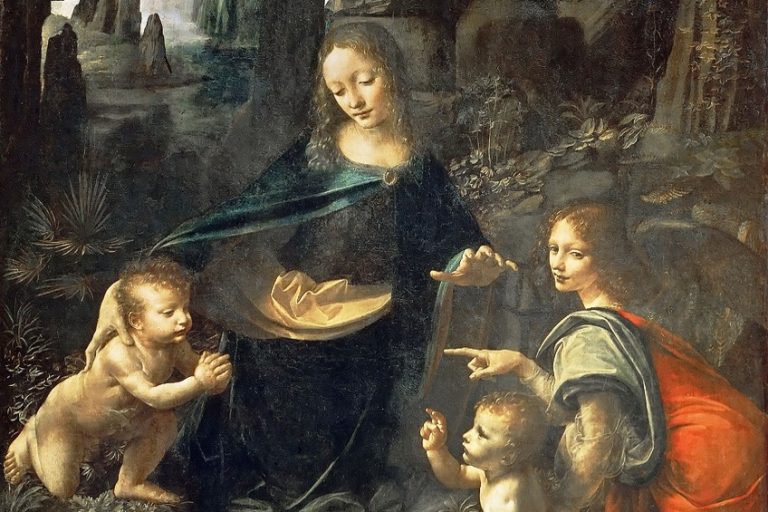“Arnolfini Portrait” by Jan van Eyck – The Arnolfini Wedding Painting
The Arnolfini Portrait by Jan van Eyck appears to be an intricately depicted yet simple representation of a rich businessman and his bride at first glimpse. However, a second look reveals a more captivating picture within this portrayal of the Arnolfini wedding. The space in which the Arnolfini marriage is depicted is strewn with visuals that denote affluence, have religious connotations, or are simply strange. In this article, we will unravel all the fascinating details of Jan van Eyck’s Arnolfini Portrait.
The Arnolfini Portrait by Jan van Eyck
| Completion Date | 1434 |
| Dimensions | 82 cm x 60 cm |
| Location | National Gallery, London |
| Medium | Oil on oak panel |
We do not even know who the pair in the Arnolfini wedding portrait is, although it is assumed to be Giovanni Arnolfini and Costanza Trenta. However, researchers do recognize that they were most probably members of the Italian wealthy class and that they were extremely wealthy.
What evidence do we have that this couple was rich and powerful?
In 15th-century Belgium, stained glass windows, the chandelier, elaborately braided blanket, fur-trimmed gowns, leather sandals, mirror, dog, and citrus fruits are all symbols of enormous wealth. Many of these visuals serve a dual purpose, expressing not only riches but also vague references to religious and reproduction themes. The lamp has one lit candle, which symbolizes God’s watching eye; the mirror is adorned with sequences from Christ’s Passion; and the untarnished mirror is also an emblem of Mary’s piety.
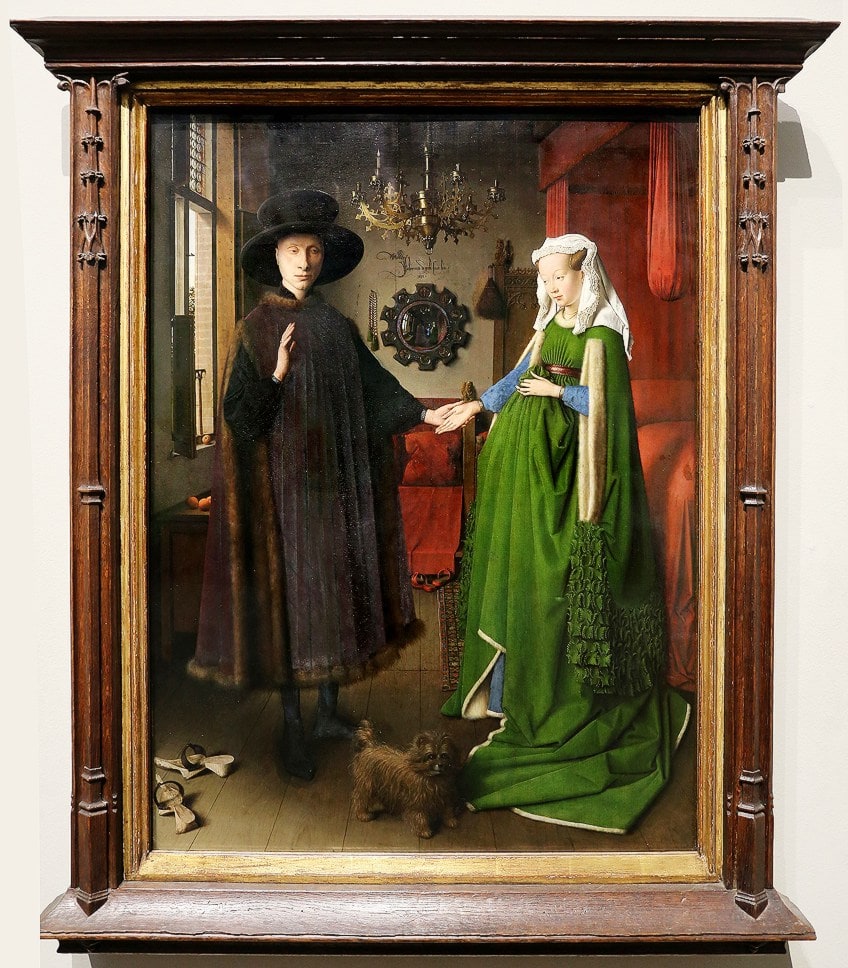
Rosary beads are also hung beside the mirror. In paintings, oranges depict fertility, and so does the red bed. St. Margaret is depicted on the finial, and the cherry tree just outside of the screen is a sign of love. We’d be hasty if we didn’t mention Signora Arnolfini’s somewhat pregnant impression.
Was this, once again, a true depiction of the pair, an optimistic desire for the future, a further indirect reference to Mary, or simply a fashionable attire? Then there are the images that appear to be devoid of context.
What is the significance of the artist’s signature on the surface above the mirror? What does the dog in the Arnolfini Portrait symbolize exactly? The Arnolfini Portrait is part of which period in art? Today, we will look at many such questions and more.
Jan van Eyck: The Artist Behind the Arnolfini Wedding Painting
The Renaissance luminaries of Italy are well-known to most of us: da Vinci, Michelangelo, Caravaggio, and so on. Northern European artists, on the other hand, contributed to the Renaissance’s status as the most significant period in art history. Jan van Eyck, who reinvented portraits, enhanced realism in Medieval artworks, and spearheaded the craft of oil painting, is among the first names you’ll come across when looking for significant northern European painters.
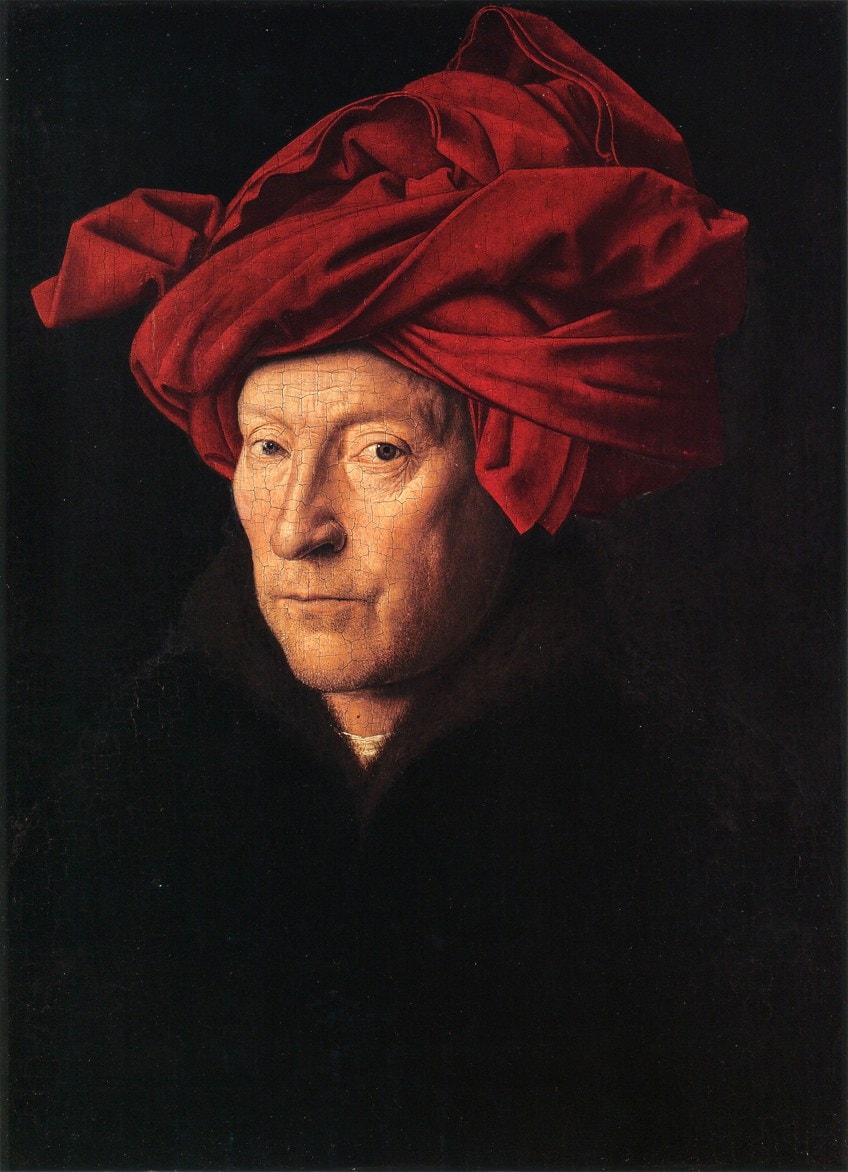
Jan van Eyck was born near the close of the Middle Ages, around 1395. The Black Death had spread through Europe, having killed roughly one-third of the inhabitants, and pervasive wars had made things even more complicated.
Little is understood about van Eyck’s childhood, but he is thought to have been born in the Flemish region of Belgium and to have grown up in the Netherlands, where he spent his adult life.
The Holy Roman Empire, commanded by the Pope and his selected emperor, ruled over the region during the time. Early works by Van Eyck can be dated directly to the aristocratic courts of John III, Duke of Bavaria, a nobleman in the region in the early 15th century. Van Eyck had a studio for the duke’s court that produced both civilian and religious artworks.
Jan van Eyck rose through the ranks after the duke’s death in 1425, painting for increasingly powerful nobles such as the Duke of Burgundy, who reigned over vast swaths of the Netherlands. Many of van Eyck’s significant works were created during this period, thanks to Philip the Good’s patronage of the arts. The duke and his companions, notably Isabella of Portugal, requested Van Eyck to produce important portraiture for them.

Even throughout his lifetime, Van Eyck was well-known, and he was one of the few painters who marked his own works. Nevertheless, Van Eyck’s career was cut short when he died in 1441. His workshop and legacy were carried on by his family, and his impact has been acknowledged and spoken about to this day.
Jan van Eyck is best recognized for his excellent portraiture, and he was tasked with portraying some of the most powerful individuals in the world at the time.
Van Eyck’s portraits of his sitters were filled with incredible accuracy and emotion. While this may not appear to be noteworthy, artworks for nearly a thousand years prior usually depicted humans in idealistic, emotionless shapes, instead of focusing on sacred subjects associated with Christianity.
Van Eyck’s portraits exemplified his secular approach, displaying his command of facial expressions and natural knowledge. To achieve the exquisite detail and colors required in realistic portraiture, he also used oil paintings, which were relatively unknown at the time. Jan van Eyck’s Arnolfini Portrait, which depicts an affluent Italian businessman hugging his wife, is one of van Eyck’s most renowned portraits. The piece is extremely detailed, right down to the fineness of the hands, which became important indicators of an artist’s competence during the Renaissance.
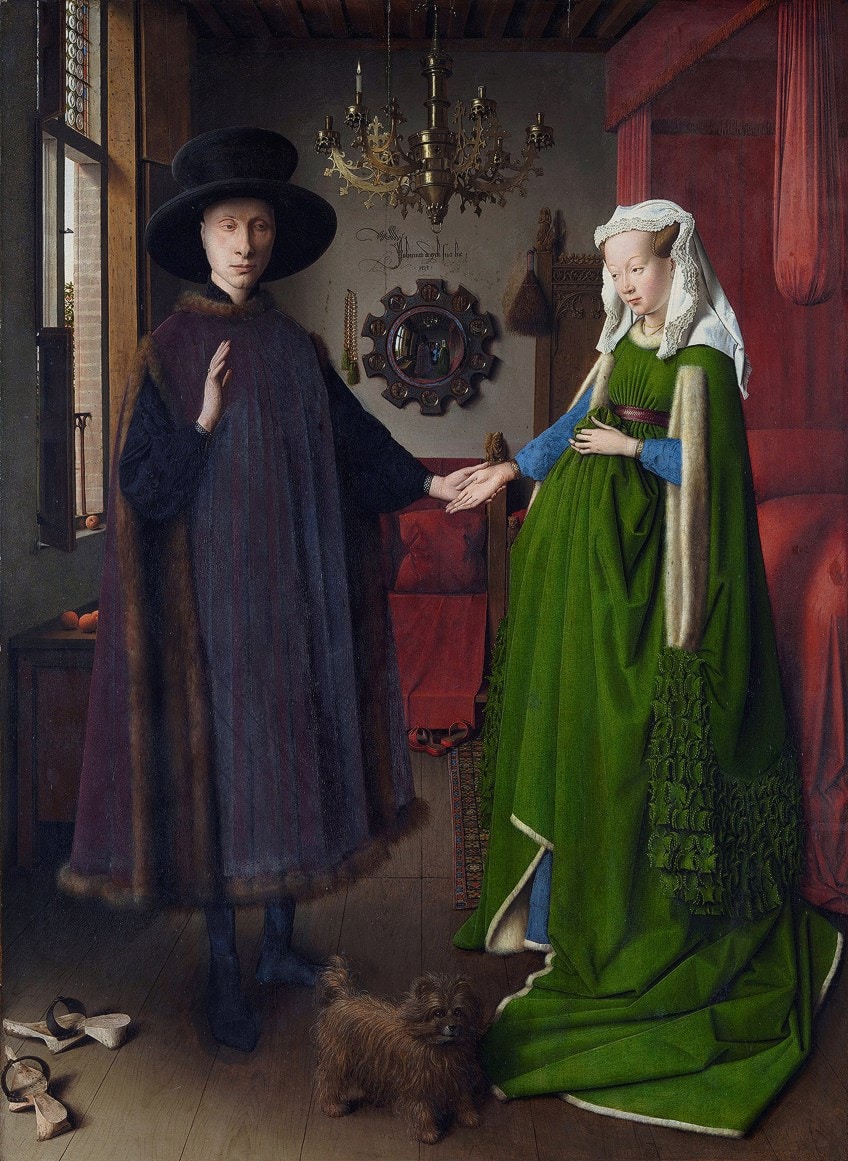
Description of the Arnolfini Marriage Painting
This painting, done in the traditional Dutch style, demonstrates an exceptional grasp of form, brushstrokes, and color to create dramatic features. The artwork is in a relatively good state, with minor losses of paintwork and minor damages that have been mostly restored.
Many minute adjustments in the underdrawing may be seen in infrared reflectography of the artwork, including both faces, the reflection, and other features.
Early summer is suggested by the blossom on the cherry tree just outside of the windows, and the pair are seen on an upper floor with a trunk and a bed. With transparent bulls-eye components set in red, blue, and green stained glass, just the topmost opening contains glass.
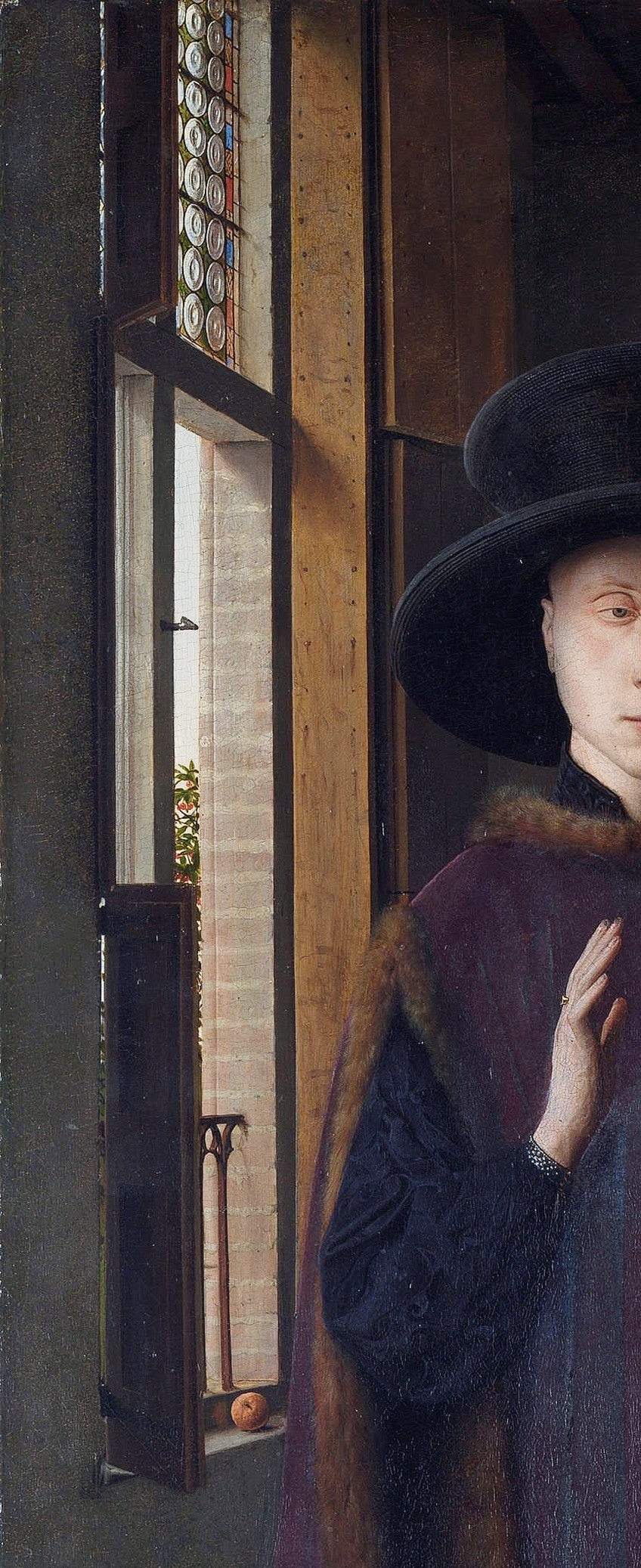
Notwithstanding the season, both of the characters’ outer clothing, his tabard and her gown, are ornamented and fully stuffed with fur. The furs could be sable for men, which is particularly costly, and ermine or miniver for women. He’s wearing a plaited straw hat colored black, which was popular in the summer at the time.
His tabard was a deeper purple than it looks now, and it was possibly made of silk velvet, another high-priced piece. He’s wearing a patterned doublet underneath, most likely silk damask. Her gown has a lengthy train and is made of complex cloth that has been folded and sewed together, then trimmed and torn ornately on the sleeves. Her blue underdress is trimmed in white fur as well.
Despite the fact that the woman’s basic gold necklace and the rings that both wear are the only pieces of jewelry visible, both clothes would have been extremely valuable, and a contemporaneous spectator would have valued them as such.

Although “the restrained colors of the man’s garments correlate to those preferred by Duke Phillip of Burgundy,” their garments (particularly the man’s) may have a component of confinement accurately reflecting their local merchant status – portrayals of nobles often seem to illustrate gold chains and much more adorned cloth.
Other indicators of affluence can be found in the room’s interior; the brass chandelier is huge and extravagant by today’s standards and would have cost a lot of money. It would have had a system with a winch and chains above to lower it so that the candles could be managed.
Van Eyck’s convex mirror in the rear, in a wooden frame with scenes from “The Passion of Christ” painting behind glass, is displayed larger than such mirrors could be constructed at the time – another subtle departure from realism.
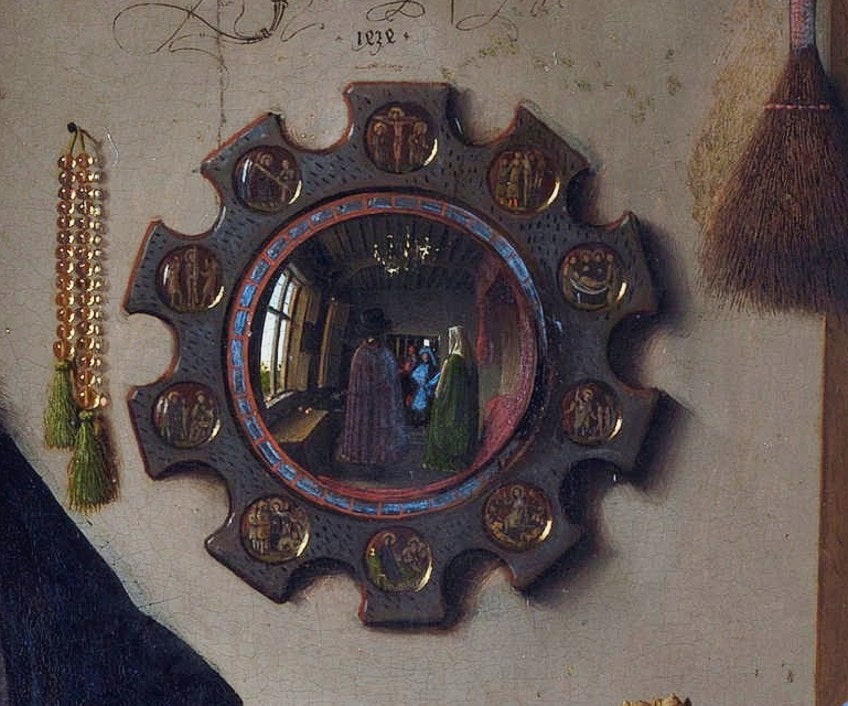
There’s no trace of a fireplace and there’s no clear spot to put one. Even the oranges on the left are an indication of wealth; they were quite valuable in Burgundy, and they could have been one of Arnolfini’s wares.
The elaborate bed-hangings and engravings on the seat and bench against the rear wall, as well as the small Oriental rug are just further signs of luxury; many holders of such pricey objects placed them on tables, as they do in the Netherlands today.
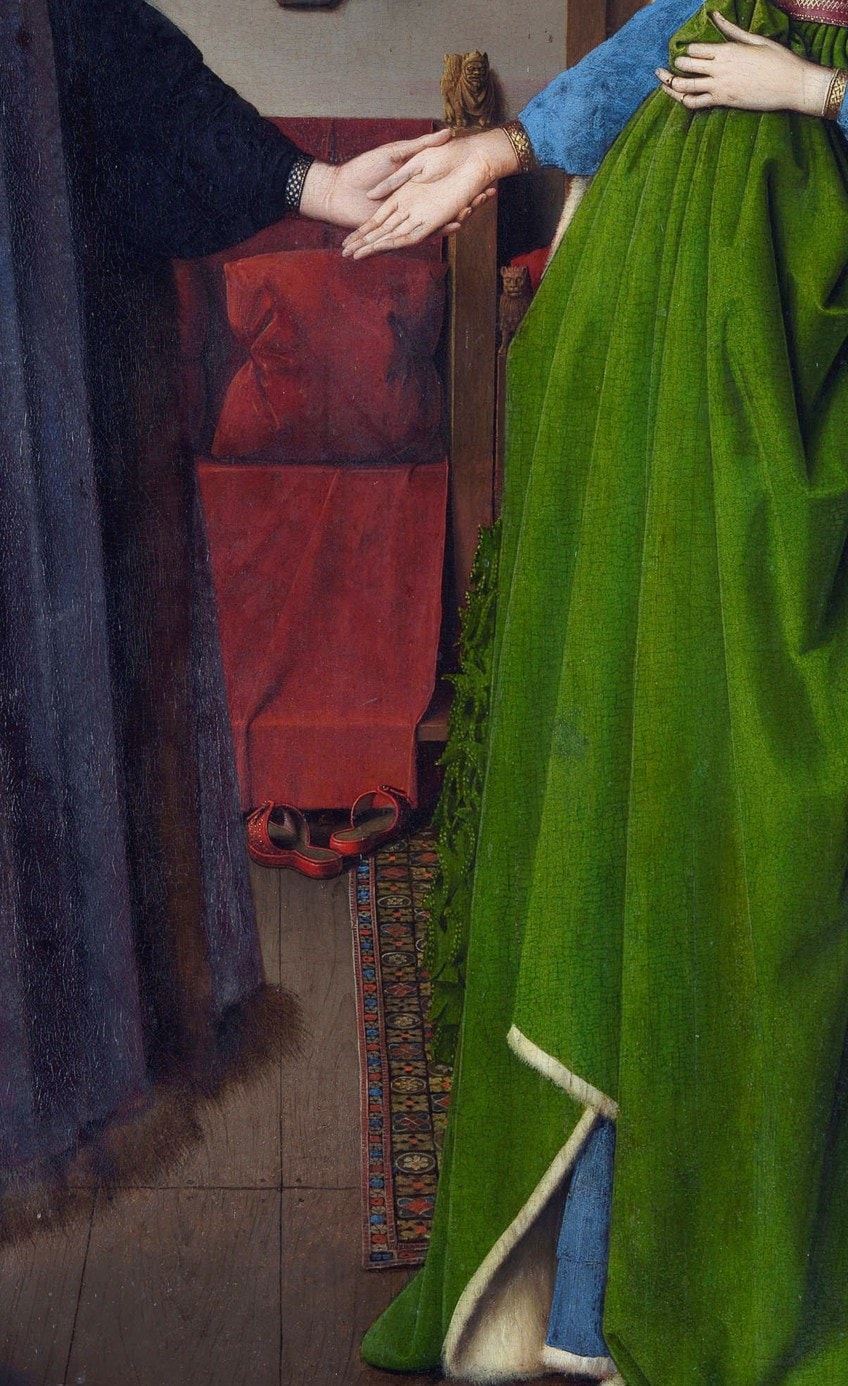
Philip the Good and Giovanni Arnolfini became friends, and Philip the Good commissioned his artist van Eyck to depict the Arnolfini Double. The relationship may have begun with a tapestry order with images of Notre Dame Cathedral in exchange for a large sum of money.
The couple is facing a door and the mirror’s reflection depicts two people in the doorway.
The second man, dressed in crimson, is most likely the artist, albeit he does not appear to be painting, unlike Velázquez in his Las Meninas (1656) painting. Historians have formed this opinion due to the presence of figures in other van Eyck artworks adorned with red headdresses. The dog is a forerunner of the Brussels griffon, which is currently a popular breed.

Interpretation of Jan van Eyck’s Arnolfini Portrait
The setting is Bruges, possibly the most significant trading center in the powerful Duchy of Burgundy at the time, but the couple’s identity is unknown from the photograph. Just over 100 years afterward, it was claimed that the double portrait might be of Giovanni di Nicolao Arnolfini, an influential Lucca trader with a Bruges headquarters, and his fiancée Giovanna Cenami, the child of an Italian businessman. This scenario is now regarded as improbable.
Van Eyck’s contribution to the Northern Renaissance School’s naturalism is exemplified in “The Arnolfini Portrait”, which exhibits the school’s outstanding command of the medium of oil painting.
The Arnolfini Portrait by Jan van Eyck is a clear indication of the sitter’s societal status. The woman’s robe has an excessive amount of cloth and is trimmed with ermine fur. A private maid would have been required to assist the woman in order to hold the gown from falling to the floor. The man is dressed in a braided straw hood and a velvet coat lined with fur.
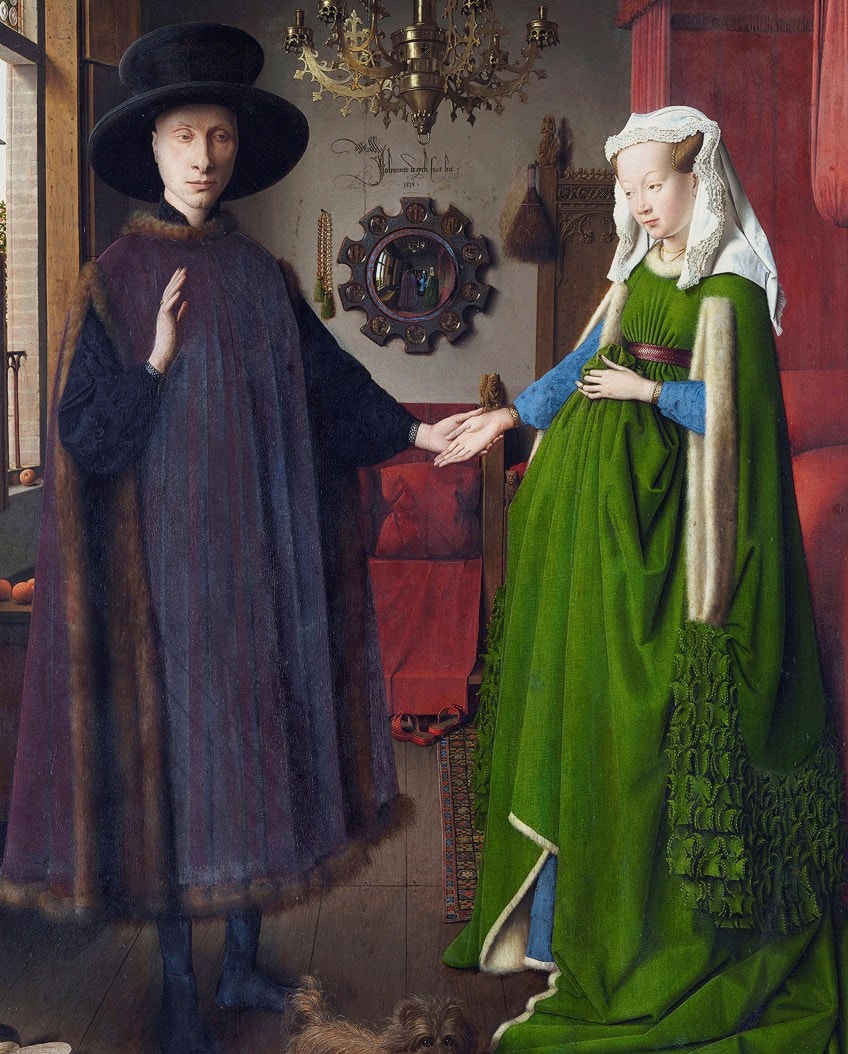
The pair’s choice of clothing put them among the richest individuals in Bruges, however maybe not at the top. The tiny size of the room, the wooden clogs are worn on the floor to keep grime off the ground, and the absence of fancy gold jewelry all link to bourgeois instead of aristocracy standing.
In alignment with the mirror, we see the pair holding hands in the center of the image: at least, the man holds his wife’s limp hand in his palm. The person’s elevated hand, suggesting he is swearing an oath, and the female’s orchestrated robe add to the pose’s formality.
We now understand what the two individuals in the doorway are seeing: they are eyewitnesses to the Arnolfini wedding. There is, however, more to the Arnolfini marriage than meets the eye.
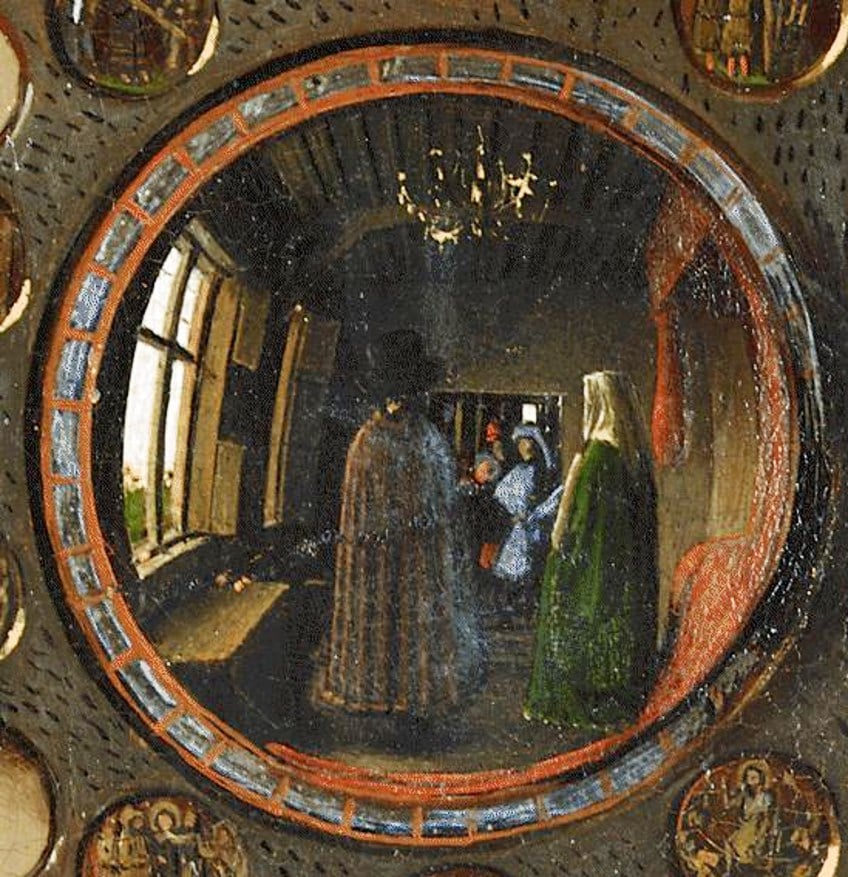
To start, Arnolfini takes his wife’s hand in his left rather than his right. This would seem to represent what was known as a “left-handed marriage” – an alliance of unequal in which the woman was forced to give up all of her usual assets and inheritance: a process similar to that of a modern-day morganatic wedding between a European royal Prince and a regular person.

As a consequence, it’s probable that both observers will be present to witness the signing of the financial agreement drawn up at the time of the wedding. They were not required for the wedding ceremony: in 15th-century Bruges, neither a cleric nor witness testimony was required.
This is also supported by the unusual sight of a single candle smoldering in the chandelier: the candle represents the ever-present Christ, whose invisible presence bears witness to the marriage vows.
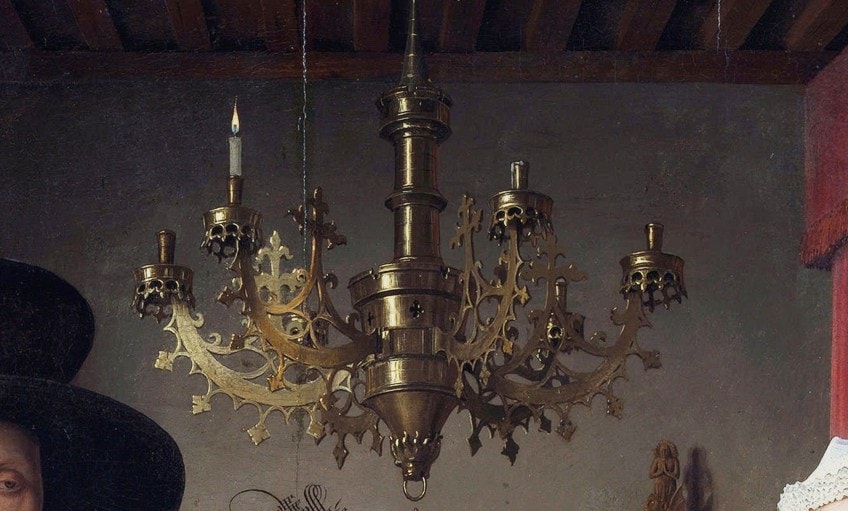
If the pair is Arnolfini and Giovanna Cenami, there is no doubt that it was a union of equals, as Giovanna was similarly well connected. Nevertheless, it was revealed in 1997 that their marriage did not occur until 1447, 13 years after the date of the works of art as well as six years after Jan van Eyck’s passing. In contrast, his brother Michele would seem to have married in Bruges at the time of the artwork. Other art historians believe the painting depicts Giovanni di Nicolao Arnolfini’s first marriage to Costanza Trenta.
The woman in the photo is not expecting a child; her bulge is only a reflection of the current trend for voluminous robes.
Nevertheless, the wooden decoration on the rear of a seat, observable underneath the chandelier, refers to reproduction. The carving over the marital bed depicts St Margaret, the saint of childbearing, implying a desire for a healthy family.

To guarantee a happy marriage, a dog is positioned at the couple’s feet. This is a symbolic reference to devotion. The iconography and meaning of the Arnolfini Portrait are practically limitless, and incredibly sophisticated, as this brief guide to the picture illustrates.
The wooden clogs could be a reference to the biblical verse “Put off the shoes from thine feet”, which indicates the hallowed character of the event taking place in the chamber.

The signature’s prominence and unique form (“Jan van Eyck was here,” rather than “Jan van Eyck did this”) are only two of the painting’s numerous ambiguous characteristics. What is certain, however, is that Van Eyck has constructed a work of significant religious significance, despite the fact that it is situated in a seemingly secular setting.
“The Arnolfini Portrait” by Jan van Eyck, along with his other artworks, had a huge impact on other Northern Renaissance painters as well as Old Masters all across southern Europe.

Identification of the Characters
The title “Arnolfini” became affiliated with this artwork through the documents of its former owners. The artwork was originally owned by Don Diego De Guevara, an important collector, who gave it to Margaret of Austria in 1516. In two different inventories of her acquisition, the name “Arnolfini” appears for the first time. The Arnolfini family, who originated in the Italian city of Luca, amassed their fortune through the trade of luxury fabrics. The people depicted in the Arnolfini Portrait are thought to be two cousins. They were both members of the Italian merchant trade and lived in Bruges.
The artwork was initially assumed to be a depiction of Giovanni di Arrigo Arnolfini and Jeanne de Cename.
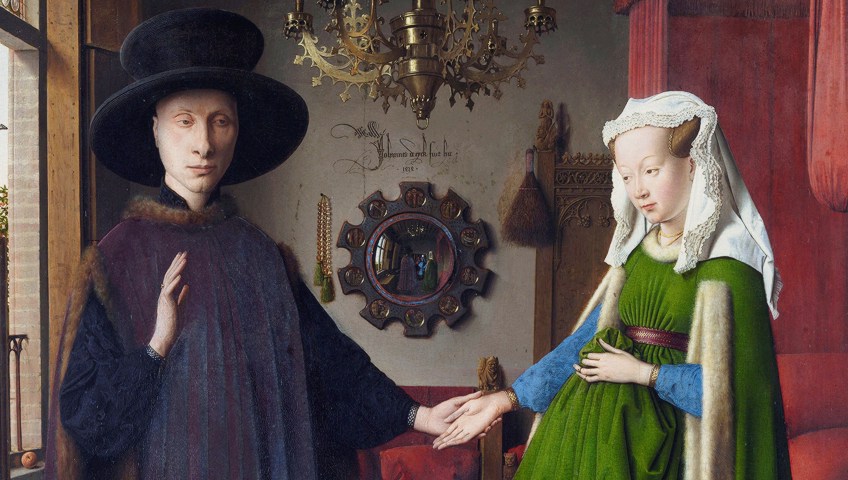
Nevertheless, according to documents discovered in the 1990s from ducal finances, Giovanni di Arrigo Arnolfini and Jeanne de Cename would not wed until 1447, 13 years after the impression was created. Giovanni di Nicolao Arnolfini and his wife Costanza Trenta, the former’s relative, are thought to be depicted in the Arnolfini Portrait. Trenta, on the other hand, died of childbirth in 1433.
Many people have speculated about the identification of the female because it was a year before the date signed on the picture.
Yet another hint that this is most likely Nicolao Arnolfini is yet another painting by Van Eyck from around 1435 called Portrait of Giovanni di Nicolao Arnolfini. The facial resemblance between the two, as well as the fact that it was a further piece purchased by Arnolfini, indicate that Jan van Eyck knew him.
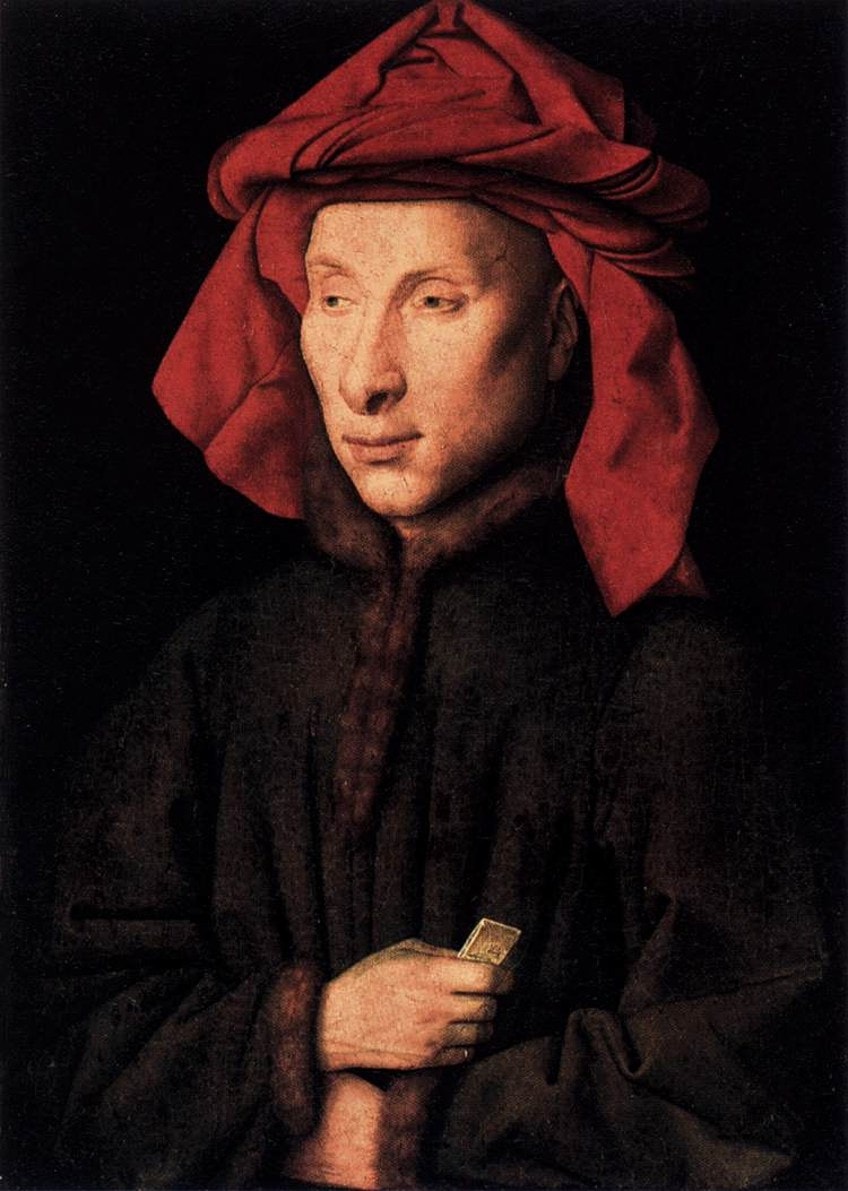
Erwin Panofsky’s piece was one of the first widely acknowledged assessments of the picture. It became so well-known that it’s one of the reasons the portrait is still known as the “Arnolfini Wedding Portrait.” The painting, according to Panofsky, depicts a wedding ceremony between Giovanni and Jeanne de Cename.
Nevertheless, art historian Margaret Koster proposes in her essay that it is a memorial picture for Giovanni di Nicolao Arnolfini’s wife, who died a year before the painting’s signature.
The write-up by Panofsky was released to the public in March 1934, while the most recent research of the couple’s putative new identities dates from the 1990s. It’s still interesting to debate his thoughts in comparison to contemporary theories because they provide insight into previous Arnolfini Portrait hypotheses that were accepted as the norm for decades.
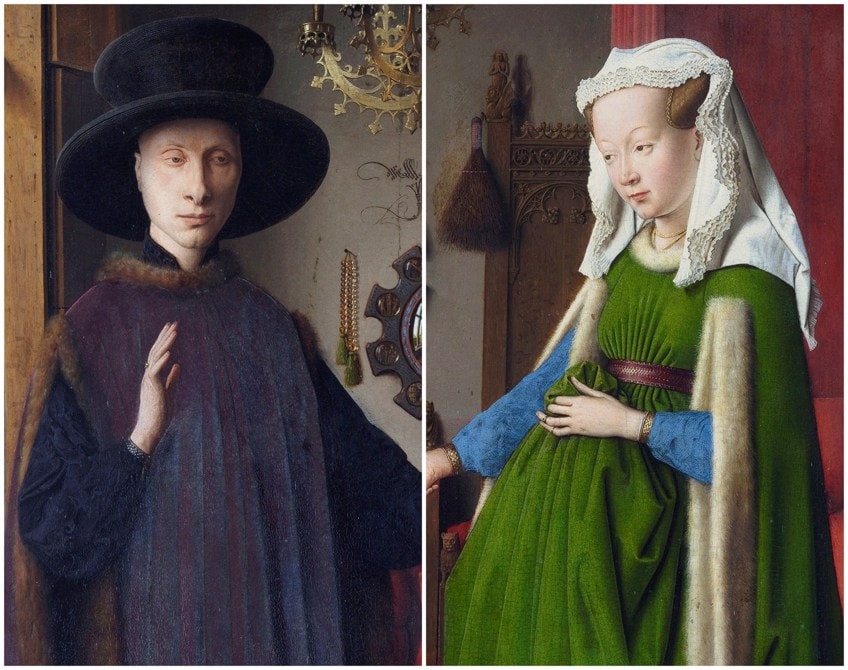
That concludes our look at Jan van Eyck’s “Arnolfini Portrait”. Because of its intricate symbolism, mathematical orthogonal perspective, and enlargement of the image space with the use of a mirror, it is regarded as one of the most unique and complicated works in Western art. Some art historians regard the Arnolfini marriage portrait as a one-of-a-kind sort of marriage contract, recorded as a painting.
Take a look at our Jan van Eyck Arnolfini Portrait webstory here!
Frequently Asked Questions
The Arnolfini Portrait Is Part of Which Period in Art?
You may be wondering what period this painting was created in. The Arnolfini Portrait (1434) has become a symbol of the Northern Renaissance. It encompasses many of the period’s artistic ideals and technological advancements.
Exactly What Does the Dog in the Arnolfini Portrait Symbolize?
The dog also brings up questions about the relevance of The Arnolfini Portrait (1434). The dog, according to Panofsky, depicts the married couple’s loyalty and devotion. Dogs have been found on female tombs since ancient Rome, according to Koster, since they were thought to guard and guide them to the afterlife. This would clarify why the dog is closest to the female, implying that she is about to die.
Alicia du Plessis is a multidisciplinary writer. She completed her Bachelor of Arts degree, majoring in Art History and Classical Civilization, as well as two Honors, namely, in Art History and Education and Development, at the University of KwaZulu-Natal, South Africa. For her main Honors project in Art History, she explored perceptions of the San Bushmen’s identity and the concept of the “Other”. She has also looked at the use of photography in art and how it has been used to portray people’s lives.
Alicia’s other areas of interest in Art History include the process of writing about Art History and how to analyze paintings. Some of her favorite art movements include Impressionism and German Expressionism. She is yet to complete her Masters in Art History (she would like to do this abroad in Europe) having given it some time to first develop more professional experience with the interest to one day lecture it too.
Alicia has been working for artincontext.com since 2021 as an author and art history expert. She has specialized in painting analysis and is covering most of our painting analysis.
Learn more about Alicia du Plessis and the Art in Context Team.
Cite this Article
Alicia, du Plessis, ““Arnolfini Portrait” by Jan van Eyck – The Arnolfini Wedding Painting.” Art in Context. May 24, 2022. URL: https://artincontext.org/arnolfini-portrait-by-jan-van-eyck/
du Plessis, A. (2022, 24 May). “Arnolfini Portrait” by Jan van Eyck – The Arnolfini Wedding Painting. Art in Context. https://artincontext.org/arnolfini-portrait-by-jan-van-eyck/
du Plessis, Alicia. ““Arnolfini Portrait” by Jan van Eyck – The Arnolfini Wedding Painting.” Art in Context, May 24, 2022. https://artincontext.org/arnolfini-portrait-by-jan-van-eyck/.





